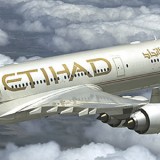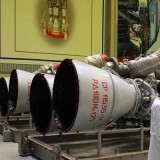Embraer’s E-Freighter E190F regional cargo jet receives full EASA certification

Embraer’s E-freighter, based on the Brazilian planemaker’s popular E190 regional jet, has received its European Authority for Aviation Safety (EASA) certification just four months after the type received full certification from the Federal Aviation Administration (FAA) in the US followed by the National Civil Aviation Agency of Brazil (ANAC). The EASA certification paves the way for the E-Freighter to begin global operations as a short-to-medium haul dedicated air cargo carrier.
The E190F program began in May 2022 to fill a gap in the air cargo market and to replace older, less efficient models. Embraer is pitching the E190F as a replacement for smaller, slower, and shorter-range turboprops. The aircraft is a passenger-to-freighter conversion, using the manufacturer’s E190 passenger plane as a platform that can be converted into a dedicated cargo-only aircraft.
It is envisaged that airlines’ progressive replacement of existing fleets of older E190 aircraft with Embraer’s new, more fuel-efficient E2 version of the type, will make many more airframes available for conversion in the future. Embraer claims the E190F offers over 40% more volume capacity, three times the range of large cargo turboprops, and up to 30% lower operating costs than larger narrowbodies. If combining capacity under the floor and main deck, the maximum structural payload of the E190F is 13,500 kg (29,700 lbs).
EmbraerThe type made its first flight in April 2024 and its first public appearance at the Farnborough Airshow in July 2024. According to Embraer, “The E-Freighter meets the changing demands of e-commerce and modern trade, which require rapid deliveries and decentralized operations, driving the demand for faster delivery of shipments to regional markets”.
“EASA certification is a key milestone in our passenger-to-freighter conversion program,” said Martyn Holmes, Chief Commercial Officer, Embraer Commercial Aviation. This is an exciting market, and we have developed the perfect aircraft to fill the gap, meeting the demand globally for faster deliveries, not just to metro areas, but all regions. The E-Jets are a global success with a large footprint worldwide, we are now ready to offer the highest standard of freighter solution to customers globally,” he added.
Positioned in the market to fill the gap between turboprops and larger narrowbody aircraft, Embraer states that the E190F “offers the flexibility to adapt to changing market trends. The E-Freighter is the ideal aircraft to take over larger aircraft operations that are sub-optimally deployed both in terms of weight and volume. They also enable expanded coverage of time-definite services to more places than before and wherever people are.”
Embraer“E-commerce demands fast deliveries and decentralized operations – something that a rightsized fleet of crossover jets like the E-Jets Freighter can offer versus larger aircraft. Full integration with pallets used in bigger aircraft allows for a smooth addition on current operational, but not necessarily optimized fleets. Being younger, more fuel-efficient aircraft, the E-Freighter can carry similar volume as their larger counterparts with much lower emissions, with lower operational costs.”
Embraer will be hoping that with EASA certification now secured, alongside that of the FAA and ANAC, the type will now prove to be an attractive proposition for airlines seeking to replace older turboprop freighters on regional routes and that orders for the E-Freighter will emerge.
RELATED
Embraer order backlog swells to record levels, 40% higher year-on-year
The post Embraer’s E-Freighter E190F regional cargo jet receives full EASA certification appeared first on AeroTime.
Embraer’s E-freighter, based on the Brazilian planemaker’s popular E190 regional jet, has received its European Authority for Aviation…
The post Embraer’s E-Freighter E190F regional cargo jet receives full EASA certification appeared first on AeroTime.




